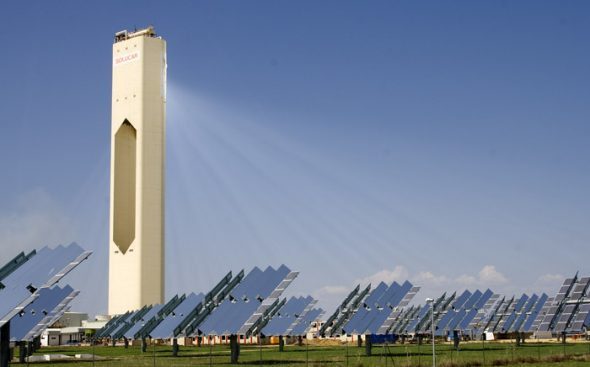The prospects of Australia finally constructing a stand alone solar thermal energy system with storage have advanced after Alinta Energy announced the results of a pre-feasibility study for solar options at its ageing and partially closed coal-fired power plants in Port August, South Australia.
Alinta, under enormous pressure from local groups who want the coal-fired generators removed, says it will now focus its studies on a stand-alone solar tower power plant with up to 15 hours storage to ultimately replace its coal fired generators in Port Augusta, South Australia.
It is an announcement welcomed by locals who have been pushing for such a project, although they may be frustrated by the timeline, which points to another few years of study.
Another irony is that any such power station would require support from a renewable energy target, or bodies such as the Clean Energy Finance Corporation or the Australian Renewable Energy Agency. Alinta recently argued forcefully for the RET to be stopped immediately.
“No new renewable energy should be supported under the RET and all new renewable energy projects, whether small or large scale, should be required to compete in the market without subsidy,” it argued in its submission. (See our story, Who is the greenest retailer in Australia?)
Still, in Thursday’s media release, Alinta says a stand-alone solar power station would be the best way forward, rather than a hybrid power plant. That’s because investors would be unlikely to support a hybrid given the limited life left to its Northern Power station.
Alinta said its study had considered technological maturity, predictability, land usage, risks to integration or operations and dual financial metrics: total installed cost and levelised cost of energy.
“Alinta Energy believes that standalone technology offers a greater potential for commercialisation than hybrid – mitigating the integration risks associated with hybridisation and offering potential generation opportunities beyond the life of its current coal-fired operations.”
 The study by Parsons Brinkerhoff identified the costs of the standalone options as above. The solar power tower, with 15 hours storage, was easily the best option.
The study by Parsons Brinkerhoff identified the costs of the standalone options as above. The solar power tower, with 15 hours storage, was easily the best option.
Some other solar tower storage projects in Australia are being pursued. Vast Solar is building a demonstration plant with the support of the Australian Renewable Energy Agency; Abengoa, which is building a 110MW solar tower with storage plant in Chile, is also considering a 20MW solar tower plus storage plant in WA, and Solar Reserve, which is building the 110MW Crescent Dunes solar tower with storage plant in Nevada (the world’s largest) has opened an office in Perth.
Still, Alinta’s head of power generation Ken Woolley, said there were significant challenges to developing such a plant, including capital costs “that are currently prohibitive”. The study estimated them at $15,926/kW – and $258.24/kWh for sent out power.
This is considerably higher than Solar Reserve’s capital costs in Nevada, and well above its estimated LCOE, which is $US135/MWh, including the kind of support from the US equivalent of the CEFC that such a plant in South Australia would likely need.
“However, Woolley said Alinta Energy is committed to completing the solar thermal full feasibility study “with the due diligence it warrants”.
“This will provide a comprehensive information-base for potential investment partners to consider should the cost of technology or regulatory environment change.” That may elicit some lower bids for its proposals.
Alinta is likely to locate the plant at the south-east corner of its facilities in Port Augusta.
Alinta is conducting a $2.3 million study with the support of $1 million from ARENA and $130,000 from the South Australian Government
ARENA CEO Ivor Frischknecht said analysis from Parsons Brinkerhoff found that a 50 MW solar thermal plant near Port Augusta’s existing power stations is technically feasible.
 “Alinta is now focusing its pre-feasibility work into a stand-alone solar thermal plant using ‘power tower’ technology that would see a field of mirrors concentrate light into a central receiver.
“Alinta is now focusing its pre-feasibility work into a stand-alone solar thermal plant using ‘power tower’ technology that would see a field of mirrors concentrate light into a central receiver.
“A stand-alone option was favoured over hybridising existing coal-fired plants due to lower technology risks and the capability to operate on a longer life cycle. This next stage of the investigation will give a clearer indication of the costs, logistics and overall feasibility of the plant.”
Frischknecht indicated that high temperatures generated by power tower technology (such as being built in Nevada) make it most compatible with molten-salt storage.
“A 50MW plant is capable of harbouring many hours of storage, presenting the key advantage of providing a steady flow of power through the night and during cloudy periods,” Frischknecht said.
All pre-feasibility work is due for delivery in early 2015. The full feasibility study is due to conclude in December 2015.
The Repower Port Augusta Alliance said Alinta Energy had made the right choice by choosing to pursue a solar thermal power station with storage, ruling out a hybrid coal-solar option.
“Here in Port Augusta, our community has been campaigning for years for a base-load solar thermal power station to be built and this decision is a major step forward for the health, economy and environment of our region,” Lisa Lumsden, Chairperson of Repower Port Augusta said.
“Solar thermal with storage gives our community the opportunity to transition away from coal, keep jobs in town and secure our long term future.










